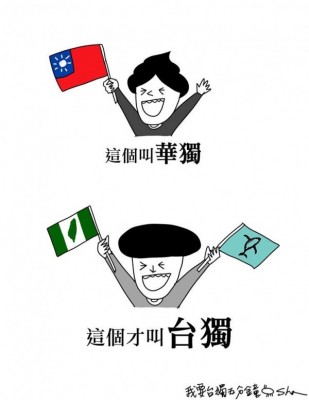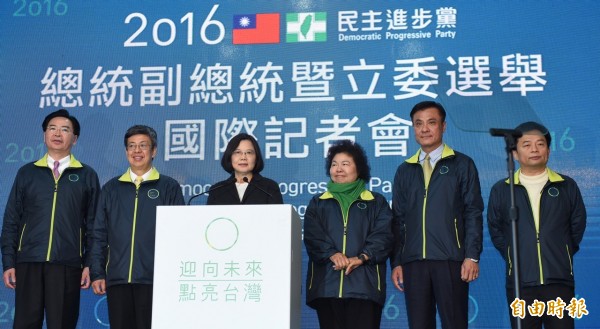by Brian Hioe
語言:
English
Photo Credit: Liberty Times
WITH REPORTS OF the victory of the “independence-leaning” or even “pro-independence” Democratic Progressive Party in international media reports on 2016 presidential elections, it may be worth revisiting what is discussed as “independence”. Namely, international media has a tendency of failing to make sufficient distinctions in regards to what is referred to as “Taiwanese independence.” Sometimes what is referred to as being “Taiwanese independence” in English language discourse is not actually Taiwanese independence at all.
To begin with, the DPP is not by any means an advocate of “Taiwanese independence” (台獨). Taiwanese independence is written into the DPP charter, but the DPP has backed off from the Taiwanese independence platform in recent years. Advocating explicitly for de jure independence, never mind that Taiwan is already a de facto independent country, is viewed as too provocative. There have been strong reactions within the DPP to removing the independence clause from the DPP charter, seeing as this would be a betrayal of the DPP’s history in the dangwai movement to form a second party in Taiwan outside of the KMT. To date this has prevented the independence clause from being removed from the DPP charter. But the DPP is anything but pro-Taiwanese independence at this point in time when it comes to the actual actions of the party.
Rather, we might refer to the DPP at this point in time as pursuing what is referred to as “ROC Independence” (華獨) in contemporary political discourse. A term increasingly common within public discourse during and after election season, ROC independence calls for at least maintaining de facto independence from China but is more ambiguous on the issue of pursuing de jure independence for Taiwan. ROC independence certainly does not call for unification with China, but it is absent of the call to localize the constitutional framework that forms the basis of the Republic of China government through establishing a new constitution or revising the current constitution.
 Recent Internet meme pointing out the difference between ROC independence and Taiwanese independence. The caption for the first image reads “This is called ROC independence.” The caption for the second image reads, “It’s this which is called Taiwanese independence.” Photo credit: 我要討厭你五分鐘
Recent Internet meme pointing out the difference between ROC independence and Taiwanese independence. The caption for the first image reads “This is called ROC independence.” The caption for the second image reads, “It’s this which is called Taiwanese independence.” Photo credit: 我要討厭你五分鐘
Taiwan would remain de facto independent from China, but it is seen as either superfluous for Taiwan to rid itself of the ROC framework or that this would be overly provocative of cross-strait relations. As Tsai Ing-Wen telegraphed in her victory speech, it does appear that Tsai views it as too disruptive of cross-strait relations for there to be any attempt made to rid Taiwan of the ROC constitutional framework, with her assertion during her victory speech that she would conduct cross-strait relations on the basis of the constitutional framework of the ROC constitution.
But ROC independence is not Taiwanese independence. Western media, not to mention Chinese language media, has failed to understand that the historical meaning of Taiwanese independence did not mean independence from China. It is an obvious fact that Taiwan has been for decades de facto independent of China, despite China’s territorial claims on it. Historically, Taiwanese independence actually means independence from the ROC framework and KMT colonialism, seeing as the KMT coming to Taiwan is often understood as the colonization of Taiwan by the KMT by Taiwanese independence advocates. It is true, however, that many of the younger participants of the Sunflower Movement who claim advocacy for Taiwanese independence did conceive of Taiwanese independence as independence from China and not the ROC framework, bringing them closer to an ROC independence position.
In this way, ROC independence calls for the preservation of Taiwan’s de facto independence, but has much more minimal claims than Taiwanese independence. The critique often leveled against ROC independence is that it is not so different from maintaining the status quo of cross-strait relations between Taiwan and China despite all signs to the contrary that this state of affairs cannot forever last.
The tensions between ROC independence and Taiwanese independence have grown equally pronounced, with the rise of post-Sunflower Movement third parties in Taiwan. The New Power Party and Social Democratic Party are criticized as seeking ROC independence rather than Taiwanese independence, for example. This is also a split within parties, figures as Huang Kuo-Chang of the New Power Party seen as closer to ROC independence rather than Taiwanese independence even when Freddy Lim, also of the New Power Party, is seen as closer to Taiwanese independence rather than ROC independence.
 Tsai Ing-Wen declaring her victory on presidential elections of January 16th of this year. Note in the background the juxtaposition of the ROC flag with the DPP flag, which resembles the green flag often used for Taiwan by Taiwanese independence advocates. During her victory speech, Tsai Ing-Wen also stated that she would conduct cross-strait relations on the basis of the ROC constitutional framework. Photo credit: Liberty Times
Tsai Ing-Wen declaring her victory on presidential elections of January 16th of this year. Note in the background the juxtaposition of the ROC flag with the DPP flag, which resembles the green flag often used for Taiwan by Taiwanese independence advocates. During her victory speech, Tsai Ing-Wen also stated that she would conduct cross-strait relations on the basis of the ROC constitutional framework. Photo credit: Liberty Times
Few have used the term ROC independence to describe Tsai Ing-Wen, but Tsai Ing-Wen has made her position sufficiently clear at this point since winning the election that we may perhaps refer to her as advocating ROC independence. This would be because renouncing the ROC framework is seen as too disruptive to maintaining peaceful cross-strait relations. Ironically enough, on the flipside, despite maintaining “peace”, the ROC’s continued existence technically means a continued civil war on paper between Taiwan and China, as there are two Chinas and two governments claiming the same territory.
But splits are emerging within the rubric of Taiwanese independence as well. Taiwanese independence exists in both “Left Independence” and “Right Independence” political positions. Within “Left Independence,” there are also splits emerging as to whether one should prioritize aiming for what is politically “Left” before pushing for independence or aiming for “independence” before trying to push Taiwan further to the Left as a nation. Thus, in recent times we have seen the emergence of the terms “Independence Left” (獨左) as distinct from “Left Independence” (左獨), the “Independence Left” stressing the importance of first aiming for an independent Taiwan then moving further to the Left. But, more broadly, it may be that further reflection on the meaning of Taiwanese “independence” is necessary.


 Recent Internet meme pointing out the difference between ROC independence and Taiwanese independence. The caption for the first image reads “This is called ROC independence.” The caption for the second image reads, “It’s this which is called Taiwanese independence.” Photo credit: 我要討厭你五分鐘
Recent Internet meme pointing out the difference between ROC independence and Taiwanese independence. The caption for the first image reads “This is called ROC independence.” The caption for the second image reads, “It’s this which is called Taiwanese independence.” Photo credit: 我要討厭你五分鐘 Tsai Ing-Wen declaring her victory on presidential elections of January 16th of this year. Note in the background the juxtaposition of the ROC flag with the DPP flag, which resembles the green flag often used for Taiwan by Taiwanese independence advocates. During her victory speech, Tsai Ing-Wen also stated that she would conduct cross-strait relations on the basis of the ROC constitutional framework. Photo credit: Liberty Times
Tsai Ing-Wen declaring her victory on presidential elections of January 16th of this year. Note in the background the juxtaposition of the ROC flag with the DPP flag, which resembles the green flag often used for Taiwan by Taiwanese independence advocates. During her victory speech, Tsai Ing-Wen also stated that she would conduct cross-strait relations on the basis of the ROC constitutional framework. Photo credit: Liberty Times